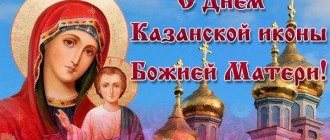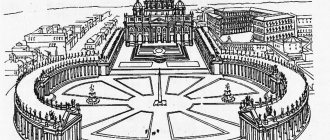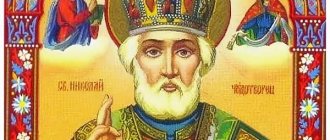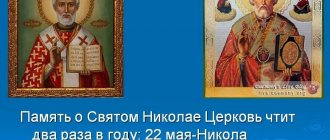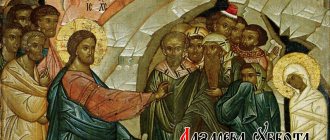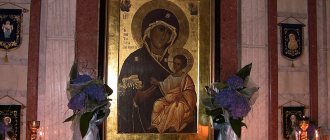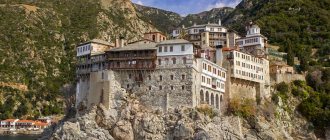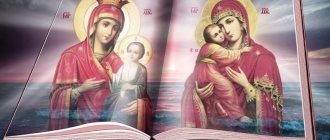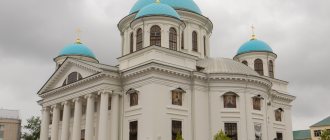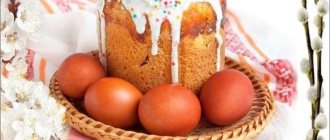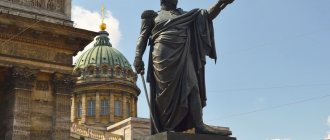The holiday of the Kazan Icon of the Mother of God is considered one of the most significant in the church calendar, which emphasizes the incredible significance of this image for the entire Orthodox world. Tsars and great generals prayed to this icon, they liberated Russian lands with it, it led pioneers to explore Siberia and healed the sick.
Let us turn to the brief history of this image and see how many miracles it has managed to create since its appearance in Rus'. After getting to know her, it will certainly become clear why medallions and bracelets with Our Lady of Kazan are so popular among Orthodox Russians.
History of the image
The history of the appearance of the icon, depicting the Mother of God and Jesus Christ in infancy, dates back to the middle of the 16th century. The Kazan Khanate was annexed to the Russian state as a result of the 3rd campaign of Ivan the Terrible in order to expand the territory in June - October 1952. From that time on, the forced baptism of the indigenous population and the eradication of Islam among the Tatars began.
The great fire of 1579 destroyed 1/3 of Kazan and claimed the lives of many citizens. A ten-year-old girl (daughter of the merchant Danila Onuchin) named Matrona had a vision three times in which the Mother of God showed her the way to the ashes of the house where the surviving icon was located with a request to find it and show it to the World. Mother and daughter fulfilled the order and dug out the holy image, preserved by the Orthodox owners, from the ashes intact.
The icon was placed in the St. Nicholas Church, where it began to show miracles of healing, fulfillment of desires, and omens. At the site of the appearance of the image, the Kazan Mother of God Convent was built, in which the image of the Mother of God was located until its disappearance (according to one version of researchers).
There is no precisely established information about the fate and location of the revealed icon. In 1904, the icon was stolen by the peasant Bartholomew Chaikin. During the investigations, he outlined versions from sale to destruction. There was a legend about the replacement of the original with a copy by a servant of the monastery and moving it to another temple, but this was not confirmed.
According to one option, the image was exported abroad. In 2004, from the Vatican to Moscow, a delegation led by the cardinal brought a list of Our Lady of Kazan (passed off as the original), which is currently located in the Kazan Mother of God Monastery. The true fate of the holy image remains unknown today.
Lists of holy images
At the beginning of the 20th century, the miraculous icon that appeared in Kazan was stolen by robbers, the precious frame was plundered, and the shrine itself disappeared without a trace. During the entire period of veneration of the holy image, many copies were made from it, which also became famous as miraculous.
After the terrible revolutionary turmoil of 1917, these lists were distributed throughout the world, and the whole world already believed in the miracles that prayer works before the icon of the Kazan Mother of God.
Today, the Russian Orthodox Church is making every effort to return shrines to Russian land; the oldest copy of the Kazan icon can be seen in the Tretyakov Gallery.
Another new phase in the history of the icon of the Most Holy Theotokos in Kazan occurred in 2004. His Holiness Patriarch Alexy contacted Pope John Paul II to discuss the icon discovered in the papal court in 1993. It is known that such an act of the Pope was another step in resolving Christian conflicts between faiths. But, regardless of his motives, he returned a long-lost sanctuary to our country. Later it turned out that this was not the original icon that appeared in Kazan, but it was a very ancient copy, probably from the original. The icon, adopted in 2004, is now kept in Kazan in the Church of St. Exaltation of the former monastery of the Mother of God, where the first icon was lost.
Copies of the miraculous icon became especially famous for their healings from blindness and eye diseases. This icon is also considered an indispensable helper in difficult and war times.
Days of celebration
The decree on the celebration of the Kazan Mother of God was issued by Emperor Alexei Mikhailovich in 1649. Since then, the Church and believers have been honoring the appearance of the icon, praying and giving praise on the days of its appearance to the people and the expulsion of the Polish invaders from the Russian land.
21 July
The summer celebration of the Kazan Mother of God is associated with the finding of a clear image on Kazan land and falls on the 21st day of July. It is generally accepted that the appeal to the Holy Face on this date reaches the Mother of God and believers are given healing from illnesses and miraculous fulfillment of desires.
November 4
The church autumn celebration of the revealed image is held in honor of the liberation of Moscow on November 4, 1612 from foreign conquerors by the people's militia led by Minin and Pozharsky. During training camps and before the campaign, the militia prayed to the Mother of God in the church asking for help in liberating the Russian land.
Nowadays, November 4 is celebrated as the Day of National Unity, glorifying the strength and power of the Russian people in the historical victory over the Polish invaders.
Prayer to the Kazan Icon of the Mother of God
Oh, Most Holy Lady Theotokos, Queen of Heaven and Earth, the highest Angel and Archangel and most honorable of all creatures, Pure Virgin Mary, good Helper to the world, and affirmation for all people, and deliverance for all needs! Look now, O All-Merciful Lady, upon Thy servants, praying to Thee with a tender soul and a contrite heart, falling with tears to Thee and worshiping Thy most pure and wholesome image, and asking for Thy help and intercession. Oh, All-Merciful and Most Merciful Pure Virgin Mary! Look, O Lady, at Thy people: for we are sinners and imams of no other help than to You and from You, Christ our God born. You are our intercessor and representative. You are protection for the offended, joy for the grieving, refuge for the orphans, guardian for widows, glory for virgins, joy for those who weep, visitation for the sick, healing for the weak, salvation for sinners. For this reason, O Mother of God, we resort to You, and hold Your Most Pure Image with the Eternal One in Your hand. As an infant, our Lord Jesus Christ, looking at You, we offer tender singing and cry: have mercy on us, Mother of God, and fulfill our petition, for all things are possible through Your intercession: for glory is due to You now and ever and unto the ages of ages. Amen.
Church service
Every person in life experiences moments of spiritual enlightenment in joy and sorrow. At this time, communication with the Lord occurs through prayer, awakening the soul and thoughts. Church service is a solemn event through which the clergy, through chants and symbols, create an atmosphere of communication between believers and God, the condescension of Grace on a person through the Sacraments of Communion, Repentance, and Blessing of Anointing. Church services in honor of the Kazan Mother of God are held on the days of her celebration. In their prayers, believers ask for health of loved ones, peace on earth, and well-being in the family.
Troparion
Church services are accompanied by chants, which are sung by the clergy in one voice, with the choir, along with all the parishioners. A troparion is a short song that reveals the essence of a religious holiday or glorifies a saint.
Text:
“O zealous intercessor,/Mother of the Lord Most High,/pray for all Thy Son Christ our God,/and cause all to be saved,/to those who flee to Thy sovereign protection./Intercede for us all, O Lady Queen and Vlad Chitsa, / like in adversity and sorrow , and in illness, burdened with many sins,/ standing and praying to You with a tender soul/ and a contrite heart,/ before Your most pure image with tears,/ and those who have irrevocable hope in You, / deliverance from all evils, / grant something useful to everyone, / and save everything , Mother of God Virgin: // For You are the Divine protection of Your servant.”
The church has established and strictly observed the order of conducting Divine services and hymns, which are divided by topic and collected in the Troparion.
Kontakion
The kontakion glorifies the saint or the celebration in his honor in poetic form, which is performed after the troparion and reveals the events in a broad sense, reflecting its details and details.
Text:
“Let us come, people, to this quiet and good haven, / to the quick Helper, ready and warm salvation, the protection of the Virgin, / let us hasten to prayer and strive for repentance: / for the lack of sorrow is pouring out upon us The Most Pure Mother of God comes to the rescue and delivers from great troubles and evils // His well-behaved and God-fearing servants.”
The troparion and kontakion are performed once at the end of the service (with the exception of Easter).
Chants can be sung at home at the end of prayer (except for the Liturgy).
A troparion and kontakion were written and performed in the church in honor of the icon of the Kazan Mother of God, which are sung at the end of the service on the days of the celebration of the Holy Image.
Strong prayer to the Kazan Mother of God - text
O Most Holy Lady Lady Theotokos! With fear, faith and love, falling before Thy honorable icon, we pray to Thee: do not turn Thy face away from those who come running to You, beg, O Merciful Mother, Thy Son and our God, the Lord Jesus Christ, to keep our country peaceful, and to establish His holy church May he preserve the unshakable from unbelief, heresies and schism. There are no imams of any other help, no imams of other hope, except You, Most Pure Virgin: You are the All-Powerful Helper and Intercessor of Christians. Deliver all those who pray to You with faith from the falls of sin, from the slander of evil people, from all temptations, sorrows, troubles and from vain death; Grant us the spirit of contrition, humility of heart, purity of thoughts, correction of sinful lives and the remission of sins, so that we all praise Thy greatness with gratitude, let us be worthy of the Heavenly Kingdom and there with all the saints we will glorify the Most Honorable and Magnificent Name of the Father and the Son and the Holy Spirit. Amen.
Folk and Orthodox traditions
The Orthodox have preserved the folk traditions of celebrating the Kazan Mother of God. There are certain rules for allowing and prohibiting actions. It is not recommended to do heavy work on holidays. Church canons prescribe attending morning, afternoon or evening services in church and turning the believers in prayer to God and the Mother of God with gratitude, honoring them for their good deeds.
Clergymen are allowed to work (if necessary) after praying or attending church. In the old days, young people organized festivities and celebrations in nature.
To this day, legends have been preserved about the infliction of physical injuries and material damage due to non-compliance with the rules of conduct on church holidays. So, while mowing, a storm with lightning suddenly struck, burning the owner’s buildings. Women did not go to the river to wash clothes, for fear of being dragged into the pool by the Vodyanoy.
Nowadays, when doing household work on Orthodox holidays, people are faced with equipment breakdowns and minor injuries in the form of bruises, cuts, and burns. With an icon depicting the Kazan Mother of God, parents bless the newlyweds for a long, happy life.
Temples
In honor of the Kazan Mother of God, temples and churches were created in Rus' and in foreign countries that were named after her (more than 1800):
- Cathedral of the Kazan Icon of the Mother of God in Moscow;
- Kazan Cathedral in St. Petersburg;
- Kazan Bogoroditsky Monastery in Kazan;
- Cathedral of the Kazan Icon of the Mother of God in Yaroslavl.
Temples and cathedrals bearing the name of the Mother of God are located throughout the vastness of Russia in the cities of Gagarin, Tambov, Volgograd, Yaropolts, in the Stavropol region, in the Irkutsk and Kaliningrad regions.
All churches are operational, have historical values, they are visited by faithful parishioners, and they offer prayers to the Mother of God and Jesus Christ.
How does prayer to the Kazan Icon of the Mother of God help?
It is the prayer to the icon of the Kazan Mother of God that has miraculous power. The text of the prayer appeal, which is pronounced on the summer holiday of the Kazan Mother of God, is identical to the one read on the Kazan autumn holiday.
The only difference is that on the summer holiday, in addition to the troparion, kontakion and magnification, a prayer to the Mother of God is said before her Kazan icon. True believers who pray to the holy image, repeatedly Fr.
How does the holy image help:
- Many Orthodox believers prefer to have the holy image in their homes, since it is believed that the Kazan Guide guides every Christian who believes in her power and wisdom on the true and safe path .
- How prayer in front of this image helps became clear after the first two blind men received their sight during the procession of the Cross. Soon, in despair, the mother of the blind baby brought the baby to the temple to this icon and began to fervently pray to the Holy Kazan Mother of God. Together with her, the parishioners of the temple and the priest offered prayers, after a while the baby began to touch his mother’s face with his hands. Everyone present in the temple was able to verify that the child was healed of blindness by the prayers of the believers. A blind monk also received his sight from the miraculous icon. After fervent prayer to the image of the Kazan Mother of God, no relief came to him, the disappointed monk went to his monastery. Soon, the Mother of God appeared to him in a dream and ordered him to continue offering prayers, then dry himself with a curtain. Having carried out the order exactly, the monk began to see.
- Healing the paralyzed in body and mind. The miraculous healing of a young guy from weakness was recorded in the city of Kazan. The young man did not get back on his feet for about two years, his parents did not stop believing in the mercies of the Lord and sincerely prayed. The prayer of the Kazan Icon of the Mother of God for help was offered both by the young man’s mother and by the young man himself. His mother prayed in the temple in front of the icon, the boy himself tearfully asked, lying in his bed. At some point, the young man felt so relieved that he was able to get to his feet and came to the temple, leaning on two staves. The fervent prayers of the mother and the young man performed a miracle, it is believed, because both of them sincerely believed in the strength and power of the holy image.
- The disease of dementia is also treated by prayers of the Kazan Icon of the Mother of God. There is a known case of the healing of a crazy man in the Kazan Cathedral from the image of the Mother of God. The young man sincerely wanted to get help and be cured, and his fervent prayers were answered.
- There is a known case of prayer treatment from the icon of the Kazan Mother of God for a serious illness of the legs . The young woman, who could no longer even walk, heard about the miraculous appearance and asked to be taken to him. In the church, she fervently and with tears began to pray to the Kazan Icon of the Mother of God, asking the heavenly Lady for help. The woman was healed on the spot, immediately during the service, and went home on her feet, thanking the Lord and Mother of God for their mercy and omnipotence. Many patients noted a significant decrease in the symptoms of leg disease after turning to this Heavenly Saint, and many cases of complete healing were also recorded.
- Many healings from cancer have been recorded through prayers to this image of the Mother of God. After all, this icon is considered an assistant in wars and battles; in the battle against a terrible disease, it will also be an invaluable assistant. Cancerous tumors are a terrible enemy of humanity, claiming lives no less than wars and disasters. That is why turning to Our Lady of Kazan for healing from a serious illness has a special meaning.
Old Believer churches
The schism of the Russian Orthodox Church occurred in the mid-50s of the 17th century during the reign of Alexei Mikhailovich. Patriarch Nikon began the reforms with the goal of rapprochement with the Greek Church. Believers and clergy who disagreed with the new canons were anathematized. The Old Believer Russian Orthodox Church experienced severe oppression. Old Believers moved to remote places in Siberia to preserve their faith.
In 1971, the Council of the Russian Orthodox Church decided to authorize and recognize the Old Believer Russian Orthodox Church, but this did not lead to mutual understanding and rapprochement between the churches. There are Old Believer churches erected in honor of the icon of the Kazan Mother of God and named after her:
- Cathedral Church of the Kazan Icon of the Blessed Virgin Mary in Kazan, built in 1912, restored in 1988, now operational;
- wooden Old Believer Church of the Most Holy Theotokos of Kazan in the city of Biysk, construction was carried out in stages in parallel with the conduct of services and rituals from 1990 to 2022;
- Old Believer Church in the name of the Kazan Icon of the Blessed Virgin Mary in Samara, erected in the period 1913 - 1916.
Currently, in Moscow and St. Petersburg, there are no Old Believer Russian Orthodox Churches consecrated in the name of the icon of the Kazan Mother of God.
Kazanskaya: what you can and absolutely cannot do on November 4
We tell you why November 4th is significant.
Historical events
1493 Christopher Columbus's expedition discovers the island of Guadeloupe.
1582 The Cossack ataman Ermak defeats the Siberian Khan Kuchum in the battle on the Chuvash Cape and three days later enters the capital of his khanate - Isker.
1708 Ukrainian hetman Ivan Mazepa announces the dissolution of the alliance with Peter I and moves to the aid of the troops of the Swedish king Charles XII.
1794 Russian commander Alexander Suvorov suppresses the Polish uprising of Tadeusz Kosciuszko.
1815 In Berlin, during an official dinner, Russian Emperor Alexander I and Prussian King Frederick William III announce the engagement of Tsarevich Nicholas (future Emperor Nicholas I) and Prussian Princess Charlotte (who became Alexandra after accepting the Orthodox faith).
1862 American doctor and inventor Richard Gatling patented the world's first multi-barreled machine gun, the Revolving Battery Gun, known in Russia as the Gatling gun.
1890 The world's first underground electric road, the Underground, opens in London.
1922 Englishman Howard Carter discovers the tomb of Pharaoh Tutankhamun in Egypt.
1942 The Moscow Engineering Physics Institute (MEPhI) was founded.
1950 Rome adopted the Convention for the Protection of Human Rights and Fundamental Freedoms, known informally as the European Convention on Human Rights.
1952 Queen Elizabeth II of Great Britain, who took the throne after the death of her father George VI, opens a meeting of Parliament for the first time.
1955 In the USSR, a resolution of the CPSU Central Committee “On the elimination of excesses in design and construction” was adopted. The era of Soviet monumental classicism is being replaced by standard functional construction - Stalin buildings are being replaced by Khrushchev buildings.
1967 The Ostankino TV tower was put into operation.
1969 The Ryazan writers' organization expels Alexander Solzhenitsyn from the USSR Writers' Union.
1970 During tests, the British-French supersonic passenger airliner Concorde exceeds twice the speed of sound.
1979 As a result of the Islamic revolution in Iran, the “revolutionary guard” seizes the American embassy in Tehran.
2008 Barack Obama wins the US presidential election.
Secular holidays
Today in Russia they celebrate National Unity Day . The holiday was established in honor of an important event in Russian history - the liberation of Moscow from Polish invaders in 1612.
Religious holidays
On November 4, they bow to the miraculous Kazan Icon of the Mother of God - one of the most revered in the Russian Orthodox Church. According to legend, after a devastating fire in Kazan in 1579, the Mother of God appeared in a dream to a girl named Matrona and ordered to find her icon in the ashes. Which is what the girl did. At the site of the appearance of the icon, the Mother of God nunnery was later built, in which the icon was kept for some time.
The Kazan Icon was in the militia led by Kuzma Minin and Prince Dimitry Pozharsky when Russian troops liberated the Kremlin and Moscow from the enemy. The day before the decisive assault, our ancestors prayed until the morning before the image of the Mother of God found in Kazan. It is to this icon that believers attribute assistance to the Russian army that entered the capital on November 4. In memory of this event, the Kazan Cathedral was erected on Red Square, which was destroyed in 1936 (restored in 1993).
Popular beliefs
Noisy and crowded weddings coincided with the holiday. “Whoever marries Kazanskaya will be happy,” they said about this in Rus'.
What can you do on this day
Even on this day, in addition to weddings, it was customary to give a good welcome to men returning from work in the city. Tables were set for them, pies and pancakes were baked, and guests were invited.
There was a popular belief: “When a young girl thought that she didn’t show her face, therefore she wasn’t in love, she tried to get up early on Kazanskaya and go to the grove. There I was looking for a birch leaf that hung low on a tree and was wrapped in frost. If you look into such a sheet, it’s like looking into a silver mirror, and all the unsightliness will disappear from your face.”
What not to do on this day
It is strictly forbidden to be angry, irritated, swear, or think negatively on this day. Try to avoid conflict situations. Do not wish harm to others and do not envy.
Our ancestors tried to postpone the usual household work - washing, cleaning or minor repairs - to another day. On this day there was no sewing or knitting. They also tried not to go on a long journey, otherwise the return journey would be difficult.
Signs
If the day starts with fog, there will be a thaw. If it rains, then winter will follow the rain: “It rains on Kazanskaya in the morning, and in the evening there is snow in drifts.” On Kazanskaya, a clear day means it will get colder.
Name day
Alexander, Anna, Vasily, Vladimir, German, Gregory, Denis, Elizaveta, Zakhar, Ivan, Irakli, Konstantin, Maxim, Maximilian, Nikolai, Fedor.
Who was born on this day
1522 Albert de Gondi (d. 1602), favorite of Catherine de Medici and Charles IX, instigator of the massacre of the Huguenots on St. Bartholomew's Night. 1650 William III of Orange (d. 1702), ruler of the Netherlands (from 1672), king of England and Sweden (from 1689). 1784 Osip Bove (d. 1834), Russian architect. 1812 Nina Chavchavadze (d. 1857), Georgian princess, wife of the writer Alexander Griboyedov. 1840 Dmitry Karakozov (executed in 1866), revolutionary who unsuccessfully attempted to assassinate Russian Emperor Alexander II. 1873 George Moore (d. 1958), English analytical philosopher. 1894 Nikolai Otsup (d. 1958), Russian poet, translator and publisher, emigrant. 1897 Dmitry Pavlov (executed in 1941), army general, Hero of the Soviet Union. 1931 Bogdan Stashinsky, USSR KGB agent, murderer of Stepan Bandera. 1946 Robert Mapplethorpe (d. 1989), American photographic artist. 1956 Igor Talkov (killed in 1991), Soviet rock musician, singer, poet, singer-songwriter. 1969 Matthew McConaughey, American actor, screenwriter, director and producer, Oscar winner.
Who died on this day
1584 Simon the Blessed, Orthodox saint, holy fool. 1856 Paul Delaroche (b. 1797), French painter, founder of naturalistic historical painting. 1866 Nikolai Muravyov-Karssky (b. 1794), Russian military leader, diplomat and traveler, governor of the emperor in the Caucasus (1854-1856). 1919 Countess Sophia Tolstaya (b. 1844), wife of the Russian writer Leo Tolstoy. 1964 Raisa Kudasheva (b. 1878), Soviet writer, author of the lyrics of the song “A Christmas tree was born in the forest.” 1973 Vsevolod Kochetov (b. 1912), Russian Soviet writer, journalist, war correspondent. 1994 Sam Francis (b. 1923), American artist and graphic artist. 1995 Yitzhak Rabin (b. 1922), Prime Minister of Israel, Nobel Peace Prize laureate (1994), was assassinated. 1995 Gilles Deleuze (b. 1925), French philosopher. 2008 Michael Crichton (b. 1942), American science fiction writer.
Miracles
The miraculous manifestations of the image of the Kazan Mother of God began from the first days of its discovery. The first service at the icon was conducted by Hermogenes, who soon received the rank of patriarch. Miracles of insight manifested themselves in the blind men Nikita and Thomas in the first days of the appearance of the Holy Icon. Small children and adults were healed: they began to see the white light and stand on their feet.
The icon had a miraculous influence on many historical events:
- assistance in liberation from Polish invaders;
- expulsion of French troops in 1812 (M.I. Kutuzov prayed to the image with officers and soldiers);
- assistance in the victory over the Nazis during the Great Patriotic War of 1941 - 1945.
- (they prayed for the lifting of the blockade of Leningrad, before the Battle of Stalingrad, for Moscow).
Miracles of the Icon of Our Lady of Kazan
In the temple books there are many records of clergy about cases of miraculous healing of the sick.
- So, one of the stories tells that a certain man named Nikita could not see for three years. He fell to the icon with fervent prayer and received his sight. After standing at the prayer service, he returned home with great joy, glorifying the name of Christ and the Most Pure Virgin Mary.
- The story of the baby's epiphany is especially touching. The mother brought her child to the temple and prayed for a long time with him in her arms at the image of the Virgin Mary. When those present noticed how the baby began to touch his mother's face, an apple was held in front of his face. The child reached out to him and everyone realized that the baby had received his sight.
- There is a known case when, by the grace of the Mother of God, a young man who suffered from relaxation received healing. He could not move his limbs, which caused a lot of suffering. Having learned about the miraculous icon, the guy, whose name was Isaac, asked his mother to serve a prayer service in front of the icon. At home, he constantly asked the Mother of God to give him the opportunity to see the shrine with his own eyes. Suddenly the guy felt relieved and was even able to get to his feet. Taking two clubs, he headed to the monastery where the image resided, and together with his mother fell to the face, thanking for the help.
There is so much more that could be listed.
Important! The mercy of the Lord and the Virgin Mary is limitless. Thousands of people who visited the image of the Kazan Mother of God were convinced of this.
Folk signs
Folk signs during the summer celebration of the Kazan Mother of God apply to the weather for the rest of the summer, the beginning of ripening and harvesting, after July 21:
- the weather became hot, the rye ripened and the harvest began;
- Cherries and blueberries ripened, jam was made from the berries;
- black milk mushrooms appeared, they were collected and salted for the winter;
- rain that day foreshadowed prolonged bad weather;
- a sunny day before lunch predicted hot weather until mid-August;
- The birth of the month with a ladle down was predicted by dry August.
Icons
There are a large number of images from the Kazan Mother of God. They are found in simple churches and large cathedrals and are revered by Orthodox believers. The miraculous abilities of icons have more than once helped people in need to heal physical ailments, console mental anguish, punish evil and provide assistance in good deeds.
The first copy of the image was sent to Moscow to Ivan the Terrible with a description of the miracles. He is revered for his assistance to the people's militia in expelling the Polish invaders. The second historically significant list is located in St. Petersburg, from the time of Peter I. It helped believers gain spiritual strength in the fight against the French and fascist invaders.
The “Vatican” list was made in the 18th century, exported to Europe during the Great October Socialist Revolution and returned home in 2004.
All lists at different historical times had a miraculous impact on real events and human destinies. The lists of the Kazan Icon, located in the churches of the cities of Shlisselburg, Moscow (Vysoko-Petrovsky Monastery), Tabynsk (Bashkiria), Suzdal, Arzamas, Vitebsk, Vologda, have a remarkable history of creation and miracles.
Help for the defenders of the Fatherland
In the summer of 1611, militiamen moved the copy of the revealed icon from Kazan to Moscow. In the autumn of the same year, the image was in Yaroslavl. It was this list that was in the Second Militia of 1611-1612, and is believed to have helped the militia led by Kozma Minin and Dmitry Pozharsky liberate Moscow from Polish invaders and restore Russian statehood. In modern Russia, November 4—the day of the liberation of the Russian capital and the end of the “Time of Troubles”—is also a secular public holiday.
After this victory of the people's militias, the icon became especially revered in Russia. Peter I prayed to the miraculous image in 1709 before the Battle of Poltava. The icon was venerated by the commander Alexander Suvorov. During the Patriotic War of 1812 they prayed for the granting of victories in battles with French troops in front of the icon.
